The shard of sandstone looks fragile in Andrew Harper’s callused hands. Kneeling in the sand like an archaeologist at a dig, his battered Akubra pulled low over his face, he cradles the find with great care. After gently brushing away the sand as if it were dust on a countertop, Andrew turns the stone over and traces the gentle grooves on its underside.
Stopped on a sandbank in the Northern Territory section of the Simpson Desert, our expedition party is very much alone. But it’s discoveries such as this that remind us that the Wangkangurru people once called this area of Australia’s arid inland home. The size of a small chopping board, this fragment was once part of a larger grinding plate, which would’ve been treasured “like a favourite spoon”, Andrew says. It was left facing downwards, he notes, pointing to the hollows left by a grinding stone used repeatedly to pummel seeds. It’s probably been sitting here, untouched, for a century or more, since the last Wangkangurru people here left the desert.
Fifty metres away we discover the grinding stone itself, which is smooth like polished concrete. “The fact there’s a stone of this size out here is interesting,” says Andrew, who admits he’s never before seen anything like it so far from permanent water. It’s possible, he adds, that the original plate was broken at Eyre Creek, and that this smaller section was brought out here because it was easier to transport.
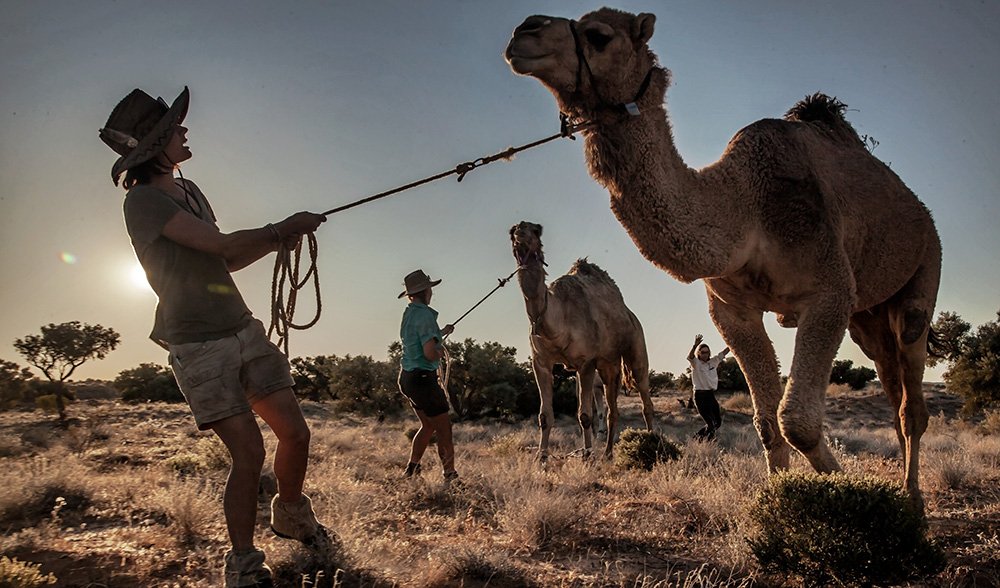
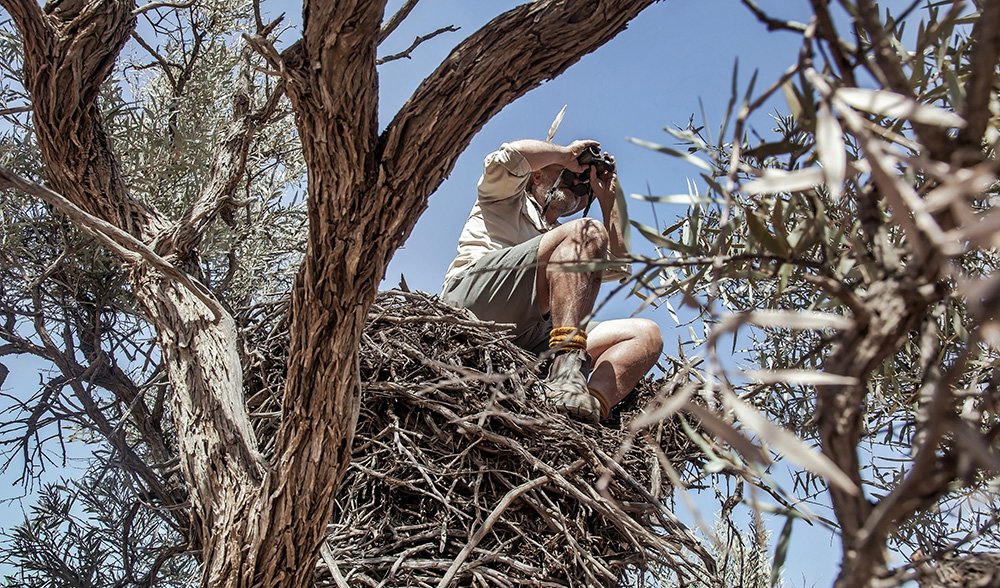
It is puzzles such as this that have lured Andrew on foot across Australia’s deserts over the past 20 years. His explorations have included a solo crossing of the continent, and amount to a distance of 20,000km or more. Some expeditions were completed solo, others with fellow explorers, but all with his camels. Photographer Thomas Wielecki and I have joined Andrew and the Australian Desert Expeditions (ADE) crew – 17 camels, four cameleers, four scientists and 11 trekkers – midway through their 18-day Great White Lakes Survey. This is the sixth of seven treks in 2014, all aimed at studying the ecology of the southern Simpson Desert. Taking slightly different routes, all will pass along the 138th meridian, from about 3km north of Kallakoopah Creek, South Australia, to the Queensland border.
Carefully combing clay pans and climbing dunes, the camel train will spend more than five months out here this year, on what is shaping up to be a unique journey of discovery.
There is something bewitching about the Simpson, as unapologetically brutal as it is. Standing atop a ridge near our camp on the first night – with the rippled ocean of swales and dunes flowing out seemingly endlessly to the horizons, east and west – is both exhilarating and a little frightening.
To Charles Sturt, the first European to penetrate central Australia, the same panorama was maddening. “It looked like the entrance to hell,” he wrote to his wife, Charlotte, in 1846. Sturt had set out to discover the great ‘inland sea’ that he was sure lay at the core of the continent, and instead found more than 1000 north–south-oriented dunes, some up to 200km long. Created by powerful winds, they make up the world’s largest parallel sand-dune desert, which, at 176,500sq.km, is Australia’s fourth-largest desert (see AG 116).
Sturt didn’t make it any further, but the Burke and Wills expedition of 1860 surpassed his limit as it hurried to be the first to cross Australia from south to north. It came within cooee of the Gulf of Carpentaria, only to be blocked by a mangrove swamp. Most of the party perished on the return journey, but its legacy runs rampant across inland Australia today in the form of hundreds of thousands of wild camels.
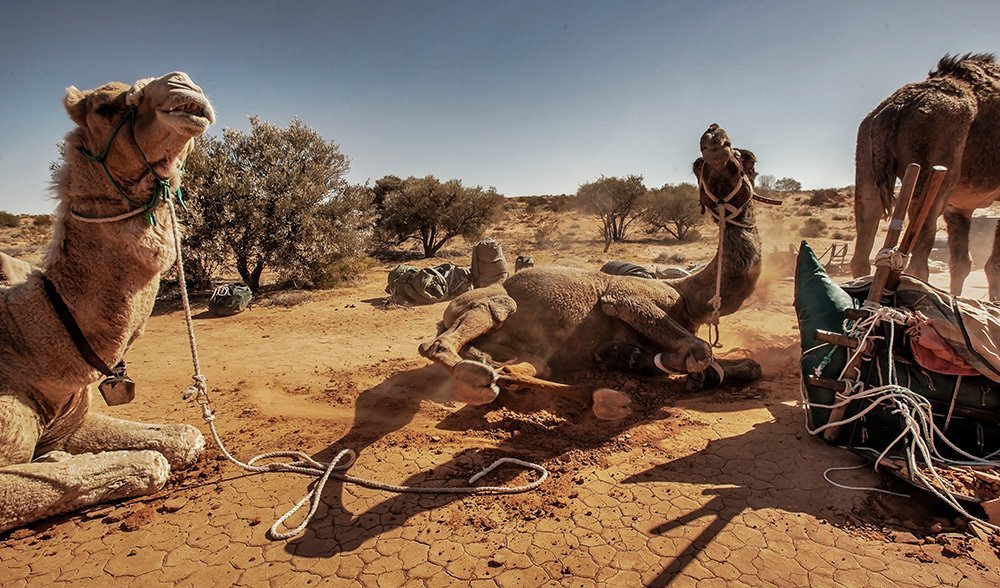
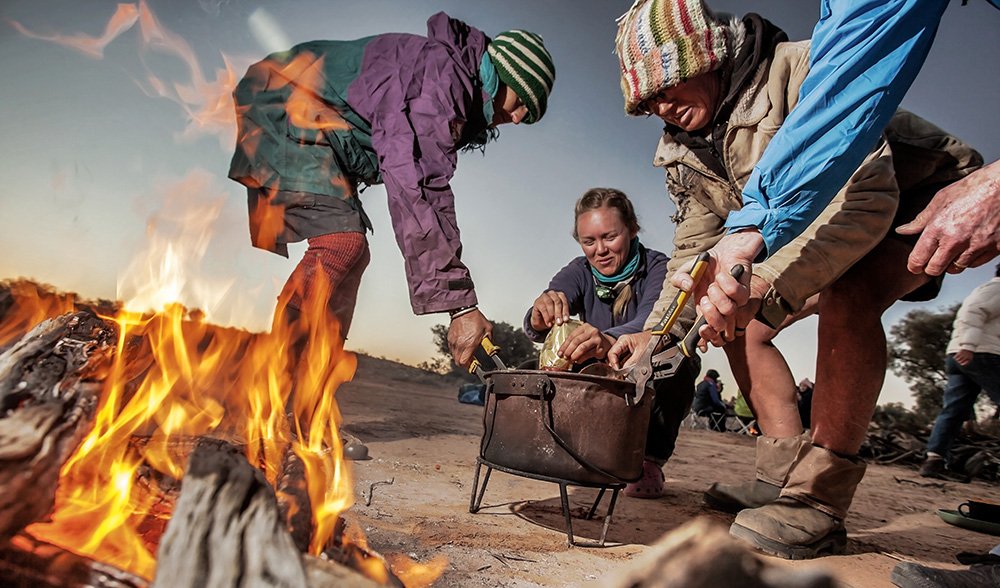
The dromedaries (Camelus dromedarius, the species of camel with a single hump) that set out from Melbourne with the explorers were from north-west India and some of the first in Australia. A further 15,000 – with about 2000 Muslim cameleers – arrived between 1870 and 1900. And it was their unusual physiology that saw them sent here in droves (see AG 33). Camels are spectacularly adapted to desert living. Depending on the moisture content in their diet, they can go for weeks without drinking. To conserve water, they pass small volumes of concentrated urine and produce dry, pellet-like faeces. Their typical walking pace of 7km/h conserves energy, keeping body temperature low, while their hump, a fat store, helps protect them from the heat of the sun.
Not only were camels the backbone of early expeditions, they also delivered supplies to remote areas, assisting on projects such as the Canning Stock Route and the Trans-Australia and Central Australian railways. However, as the interior was opened up and the motor car grew in dominance, camels were no longer needed and many were destroyed or released. It’s not known how many feral camels there are today, and estimates range from 300,000 to 750,000. In 2009 there were about 1 million, before a four-year federal culling program greatly reduced numbers. Those that remain are of robust stock, and are often rounded up and exported to the Middle East. With their ties to an iconic era in our history, camels are also a mainstay in outback tourism. You can ride one at Uluru and along Broome’s Cable Beach, or join a ‘camel safari’ into SA’s Flinders Rangers.
But it’s the paths the dromedaries forged alongside early explorers – and this unique style of expeditioning – that fires up my imagination. I can see the staggering journeys these men made as Andrew points to their routes on a map of Australia laid out in front of us. We’re crouched in the sand at our dune-top camp. The setting sun softens the scene, and the racket of the bells the camels are wearing is carried away on the wind as they feast on acacia down in the swales. After leading purely commercial desert tours, Andrew began to see the merit of combining science with eco-tourism, which led him to creating ADE in 2007. “I realised we could add a lot of value by taking experts out into the field, just as they did 150 years ago,” he says. “It’s hard to get out here and it’s expensive, so you need to get as much out of the experience as possible.”
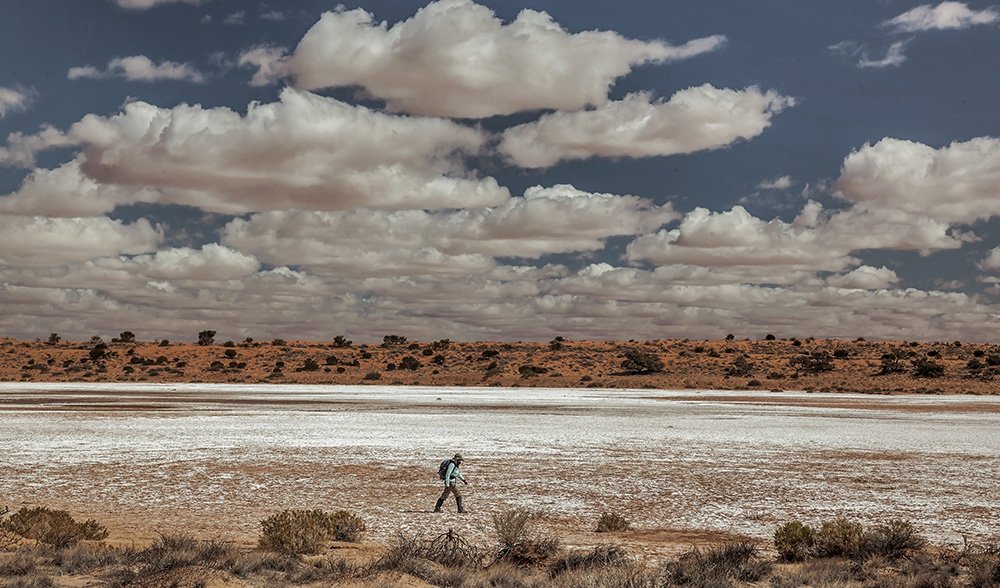
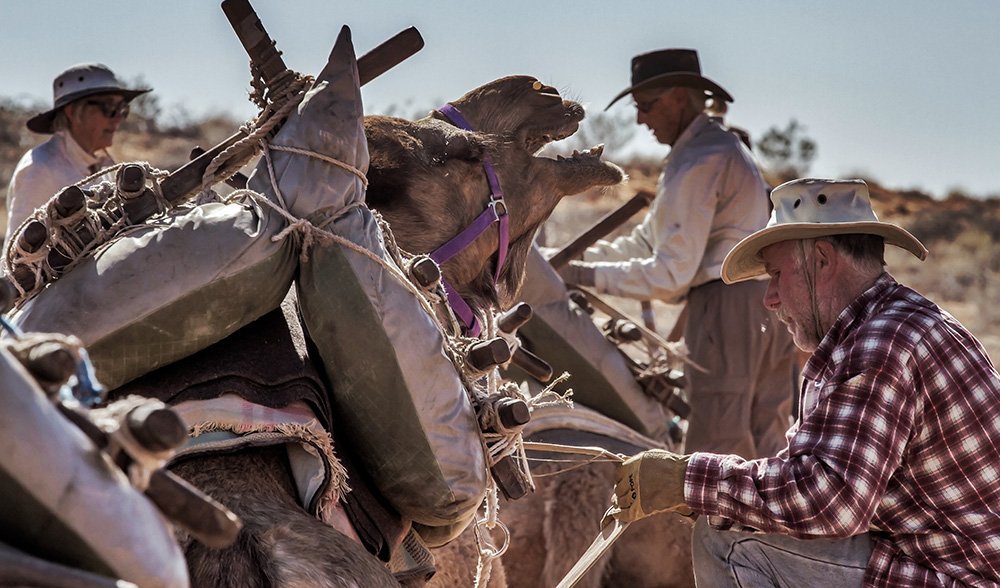
His priority is now opening up areas where scientists have only skimmed the surface. The Great White Lakes Survey – the trek on which I am participating – is examining the current state of flora and birdlife following the boom that resulted from heavy rains in 2010 and 2011. The previous month’s trek took scientists from Flinders University to Kallakoopah Creek to collect parts of a Diprotodon-like fossil found in 2006. And the survey that follows mine will move into ‘mikiri’ or well country, where Aboriginal people would have once sought water.
“We’ve worked with the Wangkangurru people from Birdsville for nearly 20 years,” Andrew says. “And they’re very keen for us to keep walking this part of the country to help them fill in the missing parts of the puzzle of where their people lived, and, in part, how they lived around the mikiri.” Leading a train of 17 camels is not a fast way of travelling, but to Andrew it is the very essence of expeditioning. “By walking country, as opposed to driving, you see and you note everything,” he says, adding that it opens up “a whole blank part on the map”.
Although camels offer astonishing access to remote areas, the logistics are anything but straightforward. Resupply points can be four weeks apart, and the camels are often carrying the food, water, swags and packs for several dozen people. That’s a weight of up to 250kg, and so it’s no surprise the morning ‘load’ is an elaborate operation. After breakfast on our second day, as the rising sun breathes life and colour into the desert, the camels are led in from the scrub surrounding our camp, lined up in two strings and ‘hooshed’, or sat down. Thomas and I are assigned to pack Morgan, a noisy and dominant bullock stationed at the end of the fi rst string of camels (‘A-string’).
Aged 25, he’s stoic and dependable; as one of the train’s ‘anchors’, he’s used to watching over the mob. In 2013 Morgan also made his silver screen debut in Tracks. Based on her book of the same name, the fi lm tells the story of Robyn Davidson, who, at the age of 27 in 1977, walked four camels from Alice Springs to the coast of WA (a distance of 2736km). Robyn has long struggled to articulate what her motivations were, but in a 1978 National Geographic feature on the adventure she said: “I love the desert and its incomparable sense of space. I enjoy being with Aborigines and learning from them…and I like the growth and learning processes that develop from taking chances” – sentiments shared by many of the explorers who feature in the pages of this journal.
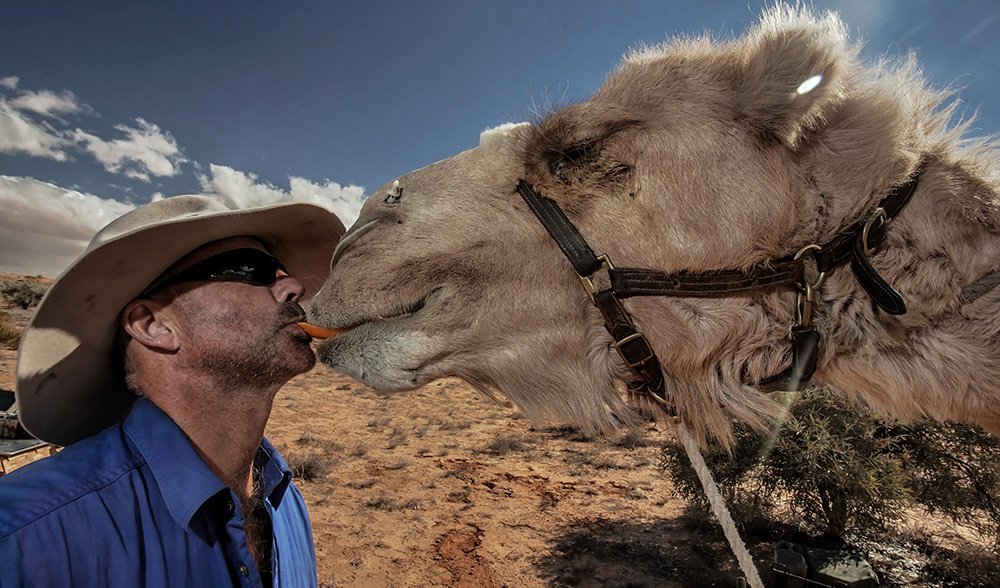
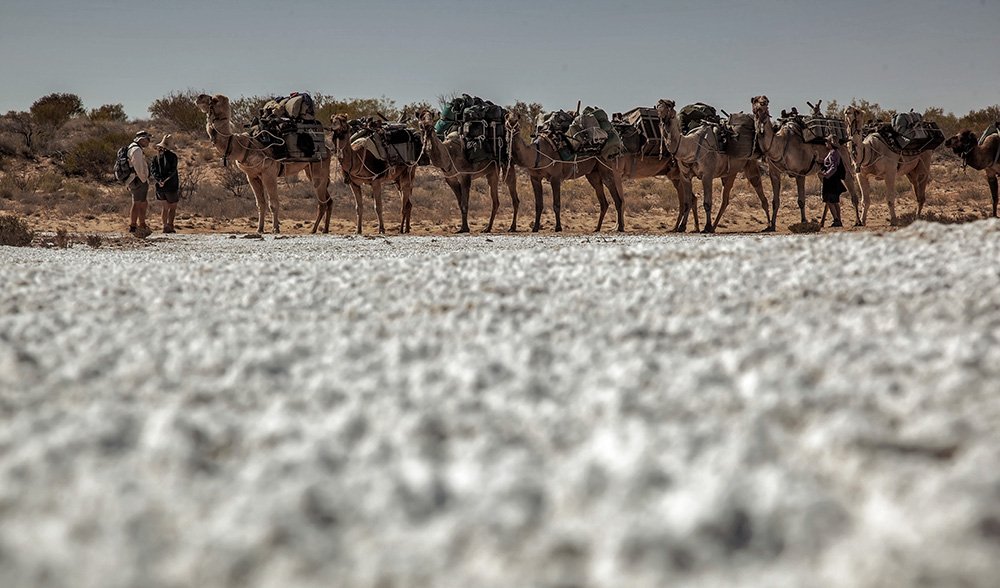
Andrew – a long-time friend of Robyn’s – assisted on the film, training the camels and actress Mia Wasikowska, who played Robyn. Morgan spent 15 weeks on the job and was unflappable throughout, much like Andrew himself. Watching them together, I can see the temperament of the cameleers reflected in the animals – when they’re calm and confident, seemingly so too are the camels.
It’s a working relationship hinged on respect and discipline, Andrew tells me. Morgan roars, gurgles and splutters like an engine warming up as Thomas and I run our fi ngers through his thick hair to remove sticks. Well-worn blankets are then arranged around his hump before the saddle and its load are hoisted on. Andrew’s saddles mirror those that Muslim cameleers used many years ago. He builds them at his home in Deniliquin, in southern NSW, and takes pride in the fact he’s honouring an original design.
As I wander about camp – among the timber boxes, coils of rope, dusty patterned blankets and patched canvas – I refl ect that there’s a timelessness to the scene, as if I’ve opened a window to the past. “We’re the last exploring camel train left,” Andrew says, as he checks the knots I’ve tied to secure jerry cans to Morgan’s saddle. “The whole day’s routine is built around these guys. All up [this year] there are five and a half months of camel-walking time, 24 cameleers, 156 people and 22 ecologists. So unless you have routine and structure, it’s chaotic – a total mess.”
It takes only one spooked camel to frighten the rest – one livewire to trip the switch and send B-string into a brief skittish frenzy. They jump and buck, rocking their saddles and loads about. Caught up in the midst of it all is cameleer Trudi Thomas-Morton. They dance towards her like creatures possessed, rousing clouds of sand. Thankfully, her tiny 55kg frame slips past as the other cameleers rush forward to cajole the panicked animals.
Arms outstretched, their soothing calls of “Here camels, oooodou camels” are enough to placate. You always hear a rush before you see it, Trudi tells me later, at our camp overlooking the shimmering expanse of Lake Thomas. The camels have been hobbled and unloaded, the kitchen unpacked, a fire of gnarled gidgee branches lit and the billy set to boil. Makeshift bedrooms are popping up among the scrub as swags are unloaded and damp socks pegged to trees. “With their hobbles and loads shifting…it’s kinda like a wave rolling in,” she adds. “And if you have no respect for what they can do, you’re going to get seriously hurt.”
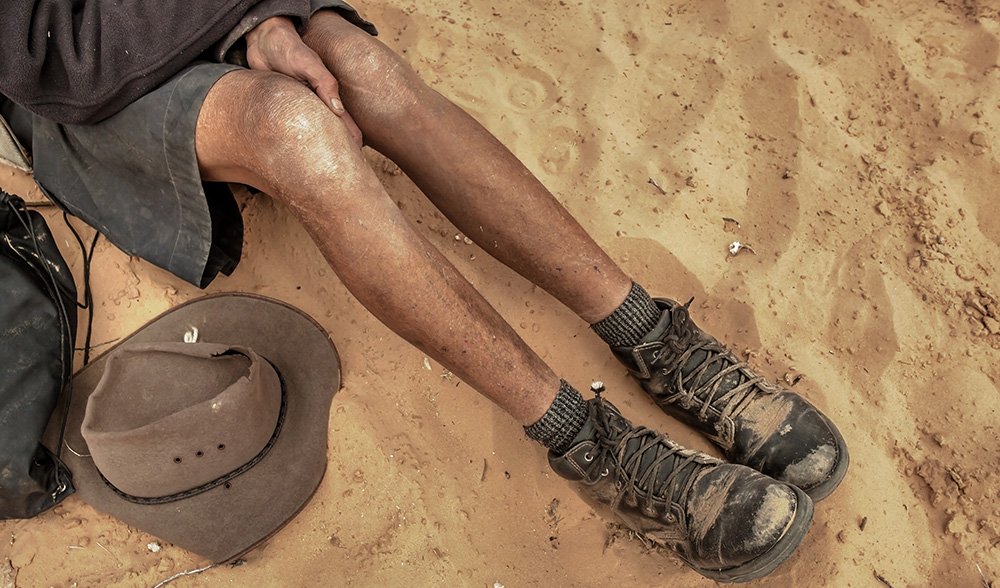
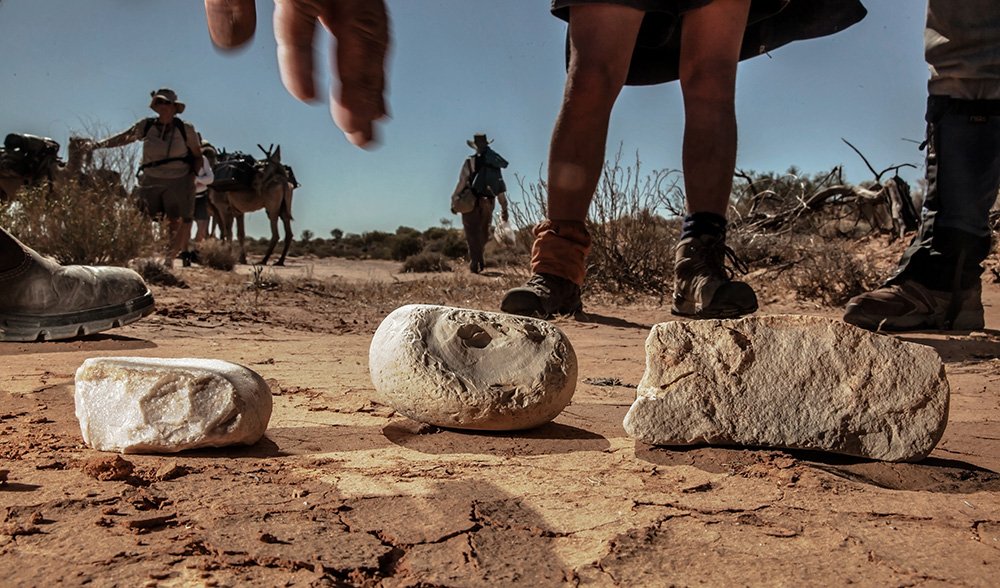
Having worked as a jackaroo and then a stockman in the merino industry, 50-year-old Andrew has spent most of his adult life around animals. In 1995 he began thinking in earnest about a long-held dream to walk across Australia, following the Tropic of Capricorn from west to east, and figured that to do so he’d need to know camels – a process that took four years. Andrew learnt the ropes from other cameleers, including adventurer Rex Ellis, who, in 1976, established Outback Camel Company, the first commercial camel trekking outfit in Australia. “It’s a lot easier to work with camels because they’re more sensible and sure-footed and less flighty than horses, which is a reflection of the environment they live in,” Andrew says, readjusting the lead rope on TC as we talk.
At 35, TC, or ‘Tall Camel’, is the oldest of the mob and “arguably Australia’s most travelled dromedary”. He’s crossed the continent twice and joined Andrew on all of his desert treks – including 12 Simpson Desert crossings – and is due to retire soon. Although he’ll live out his days in a paddock, TC and the rest of the mob were caught in the wild. “Because there’s hardly anyone else doing what we do, you can’t go and buy a trained pack camel off the shelf,” Andrew says. Instead, he procures camels that have been taught the basics – to sit (“hoosh”), stop (“oodou”) and walk (“ibna”) – then builds on those instincts. Most importantly, though, newcomers learn from the others, observing how older camels carry a load over the dunes, for what could be 2500km in a trekking season. And for the most part, interactions between camel and cameleer are fluid.
“They’re highly intelligent animals,” says Trudi, who, like Andrew, has worked with horses. After reading Tracks and being inspired by Robyn’s story, this New Zealand-born 57-year-old joined Andrew on a Simpson trek in 2001. Trudi was working as an assistant to the deputy prime minister of NZ at the time, and returned home deeply affected. “It’s interesting because people change out here. You can see it happening…they seem to find the strength to just be. Everybody starts to look a bit more natural,” she says. And it’s true that with their dusty clothes, sunburnt skin and flyaway hair, the cameleers look almost like creatures of the desert themselves, blending in as naturally as the camels.
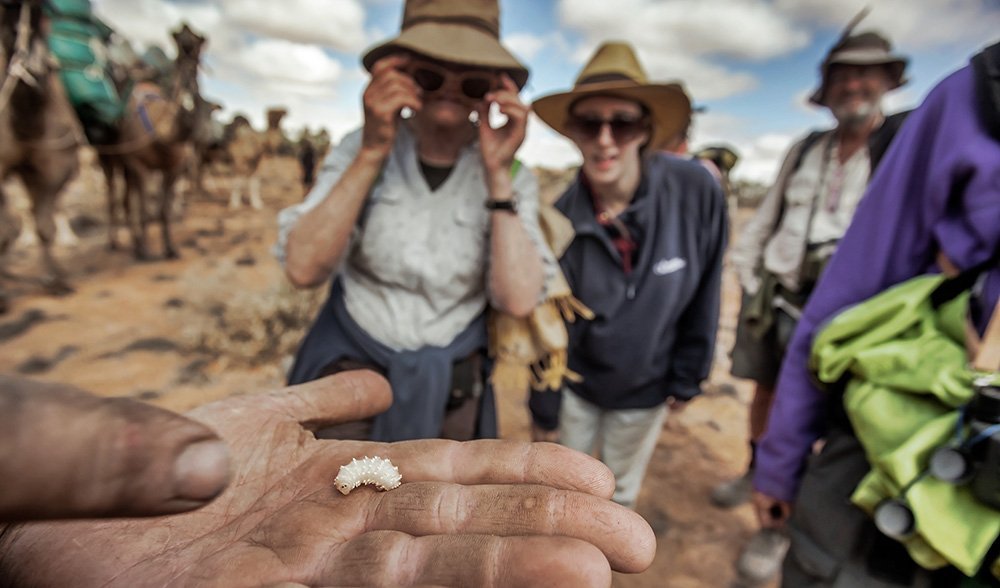

Today, Trudi divides her time between a desk job and work as a cameleer. The latter is a 24-hour-a-day gig that sees her sleeping among the mob in case wild camel bulls wander into camp – something we haven’t experienced out here. Should that occur, it often means a night of interrupted sleep for the cameleers, who will try to scare the bulls away before bringing out rifles. And that’s following a day crammed with cooking, loading and unloading, shepherding, trekking, navigating and mending. Nevertheless, Trudi says she’s at her most confident out here, even despite her diminutive stature.
“For the camels to trust you I think you have to trust yourself around them, trust that everything is going to be okay,” she says. It’s taken more than five months for Ann Hamilton, a cameleer-in-training, to begin to develop that confi dence. This mother-of-two from Tasmania joined Andrew on three desert trips before leaving her job as a commercial lawyer. “I just knew I had to keep coming back,” she says in her whispery voice. Friends and family thought she was having a midlife crisis, but “I’m the happiest here that I’ve ever been in my life,” she says. Assigned to the tail-end of A-string, Ann has spent much of the past few days taming Saber, a pretty young cow with lashes as long as my fingers, who was rescued from an abattoir.
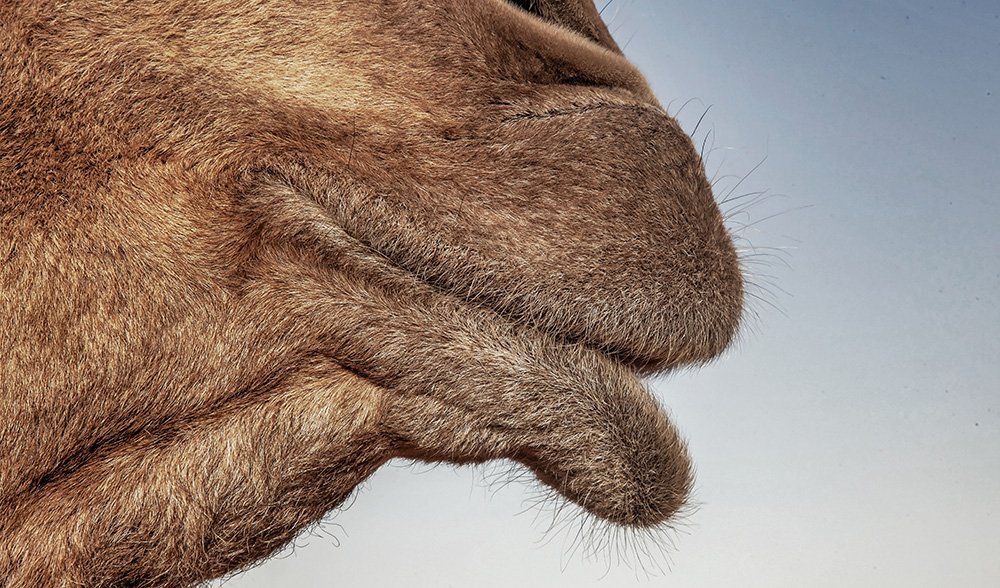
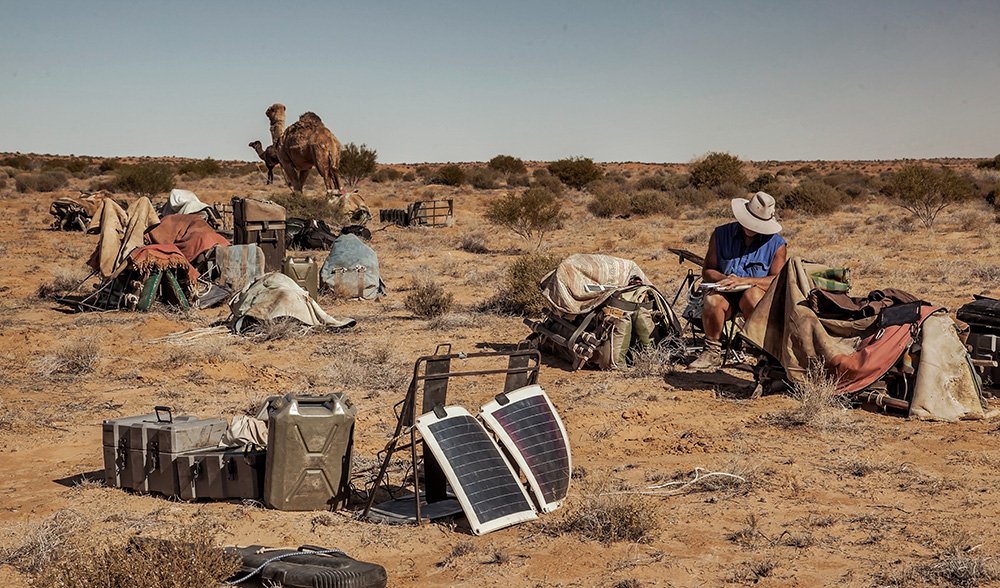
Nicknamed ‘Fluy’, she looks like a darling but is often lashing out – a likely by-product of a traumatic childhood. Using her hat as a shield, Ann cautiously navigates the load each morning. Watching them together – Ann ducking and weaving as Fluy tries to nip her – I can’t help but think they’re both still adjusting to life out here. “I had an incident with one of the camels where I was bitten, and that taught me about the need to respect them and be wary,” Ann says, referring to the time Marty clamped his mouth around her head before quickly letting go.
“But although Fluy is really naughty, she does respond to consistency. And then there’s camels like Billy, who carries the vegies and who’s a sweet young boy, and Jemma who is reliable and Sultan who roars and Banjo who’s an absolute clown – I love all of that.” A deep a section for these animals is essential, Andrew says. And that regard seems to be mutual. The camels recognise him by his smell, his voice and his shirt, Trudi tells me. They’re calmer when he’s near and seem content to have him lead the way. “They think I’m part of their mob,” he says. “Not just because I’m out the front holding the rope, but also because I’m living with them out here for five months of the year.”
“Days of extraordinary freedom” was how Robyn Davidson described the high points of her journey in 1977. I think of her as we fan out like a search party across the dunes on our fifth day. It doesn’t take long to feel cocooned out here – hidden from the world among the folds and prickles of the land. After long days walking across country on our own, it’s a shock when we reach a track, at the NT/SA border, and meet a couple in their four-wheel-drive. They stop to take a picture of the camel train and 21 bedraggled, unwashed people. The arrival of the vehicle bothers Andrew; it seems to have woken him from a kind of desert reverie. Suddenly shy, he ushers A-string into a semi-circle so he’s hidden from view.
“Every year it gets harder to leave this world and step back into the other Australia,” he tells me, as we sit under the shade of a gidgee. “I feel like a visitor in my own country after being disconnected from civilisation for five months. But I still think it’s important that people…strip themselves back from technology and the obsessiveness of being connected, and look at that other connectivity, which is back to the land that we depend on.” For a dry year, we’ve uncovered more than botanist Rosemary Purdie expected. Out of the 630 species that are known to this region, she’s identified 125, and collected 36 seed samples for the Australian National Botanic Gardens in Canberra.

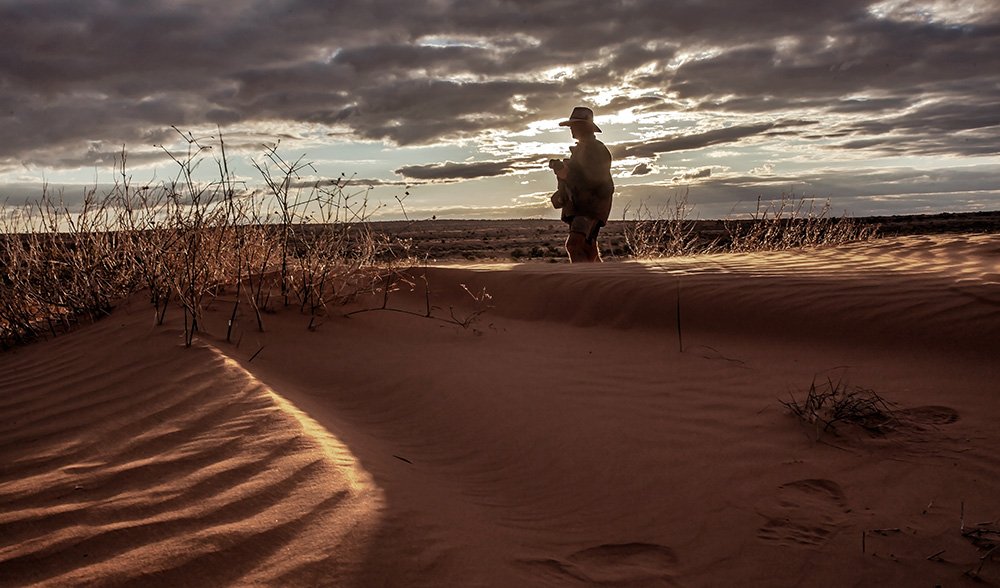
On our travels we’ve also sprung a brown snake, lizards, and a whimpering litter of chubby dingo pups. “It’s been quite amazing,” Rosemary says, as we cram in close around the campfire that night. The flames illuminate our windbeaten brows as thousands of stars flicker overhead. “It says to me that even though it is dry, in a large area – somewhere – there will be the right conditions for species to be flowering and setting seed. You don’t need the really wet conditions.” Ornithologist Julian Reid has been comparing birdlife with what he observed in 2009, the start of a series of wet years. In that boom time he noted 110 species; these past few weeks he’s recorded only 51.
“In this arid desert in the dry times there is a very limited diversity of birds,” he says. “That’s valuable to know – it’s brand-new knowledge.” And for Andrew, each new discovery is motivation to keep on walking, even though this double life he leads is one of extremes. “I’m still partly a creature of the 21st century,” he says, “who likes the diversity that our culture offers.” I suspect, though, that given the option, he’d choose to always be out here among the ghosts of those explorers and the offspring of their original dromedaries.
